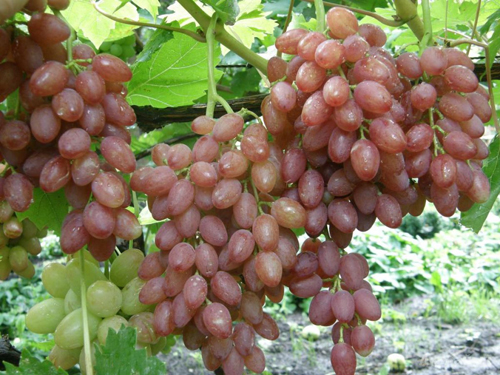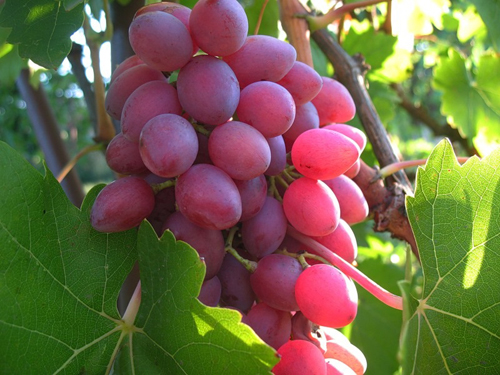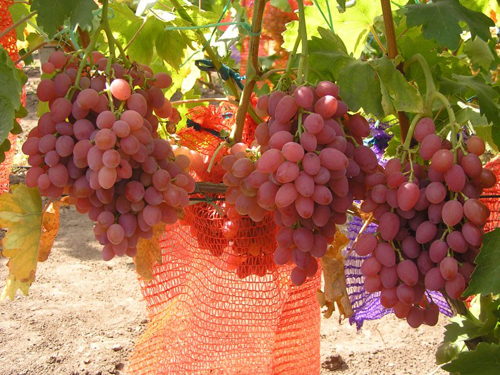Grape variety Kishmish radiant
Seedless grape varieties in the minds of many inhabitants are very capricious and difficult to grow. And this opinion has a certain basis, because the traditional Central Asian varieties of raisins are really poorly adapted to growing in a temperate climate with some frosty winters. However, scientists from the Moldavian Institute of Viticulture and Winemaking tried to debunk this stereotype by creating a wonderful variety of seedless grapes Kishmish radiant. Its authors were M.S. Zhuravel, I.P. Gavrilov and G.M.Borzikov. The new hybrid was obtained by them from a combination of crossing the varieties Cardinal and Kishmish pink.

Our hero is distinguished by early maturity, high yield, increased frost resistance in comparison with traditional seedless varieties, attractive type of bunches and excellent taste. At home, it has been zoned since 1992, in Russia it is included in the State Register of Breeding Achievements in the North Caucasus (Republics of Adygea, Ingushetia, Dagestan, Kabardino-Balkarian, North Ossetia-Alania, Chechen, Crimea, Rostov Region, Krasnodar and Stavropol Territories) and the Lower Volga (Republic of Kalmykia, Saratov, Astrakhan and Volgograd regions) regions since 2004. Widespread among amateur winegrowers.
Agrobiological characteristics
Radiant Kishmish bushes are above average vigor. Leaves are medium, rounded, five-lobed, medium and strongly dissected. The leaf blade is light green, shiny on top, not pubescent below. The upper lateral notches are open vaulted or closed ellipsoidal, the lower ones are open, barely outlined. The petiole notch is open, in the form of the Latin letter "V". The petiole is long. The denticles at the ends of the blades are narrowly triangular, and the lateral denticles are triangular with a wide base. The flower is bisexual; grapes do not require additional pollinators.
Bunches of this variety are above average in size and large (average weight is from 400 to 700 grams and more), conical or cylindro-conical, often winged, loose. The combs are fragile. The comb is of medium length, the stems of the berries are long. Berries of Kishmish radiant medium size - 22 × 17 mm, weighing 3-4 grams, ovoid, in a bunch are located freely, not compressed. The skin is thin, but strong, colored in a beautiful golden or red-pink color with a crimson tint. In the sun, the berry seems to shine from the inside, for which the grape was obviously called radiant. The taste is neutral, very pleasant, harmonious. By consistency, the pulp is juicy, dense, fleshy. There are no bones.

The crop is intended for fresh consumption, drying, use in confectionery production. The bunches have an excellent presentation, transportable. Suitable for long-term storage. The tasting score is 9.1 points out of 10 possible. Among the seedless varieties, our hero is one of the largest-fruited, although for table grapes the size of the berries is not outstanding. They are not prone to cracking, however, excessive stress and unfavorable growing conditions can actualize this problem.
Early maturing radiant kishmish. The duration of the growing season from budding to full maturity (in the south - the first decade of August) is 130 days. In this case, the plant needs at least 2500-2550 ° C active temperatures. Due to the early ripening, it is possible to grow these grapes in the middle lane, where it will only be necessary to cover the vine more thoroughly for the winter.
The yield of the variety is high - 100-120 centners per hectare of fruit-bearing vineyard. However, it is important not to allow overloading of the bushes, which can lead to such negative consequences as shrinking, the appearance of wateriness, cracking of berries, a decrease in sugar accumulation, potassium starvation and a deterioration in the winter hardiness of the bushes.
Under favorable growing conditions and a high agricultural background, the ripening of the shoots is good (85%). The percentage of fruitful shoots is 65. The number of clusters per developed shoot is 0.9, and per fruitful is 1.3. The sugar content of grapes is 16-17 grams per 100 cubic centimeters, the acidity is 6.0-7.0 g / l. The ripe crop can hang on the bushes for a long time, improving the sugar content by up to 20%, but only if the bunches are reliably protected from damage by wasps.

Agrotechnical features
Positive properties when growing Radiant Kishmish are good growth vigor, quick fruiting, resistance to powdery mildew, and frost resistance, although average for ordinary varieties, but high for seedless ones. It does not have resistance to gray rot, but it avoids being damaged by it due to early maturity. Grapes are susceptible to mildew, requiring multiple chemical treatments against this disease. It is damaged by phylloxera at the level of common European varieties, and therefore requires reproduction in a grafted culture in the zones of infection by this soil pest. Fusion with the recommended rootstocks (Riparia x Rupestris 101-14, Berlandieri x Riparia CO4) is good.
Due to insufficient pollination, no tendency was noted for peeling berries. At the same time, Radiant Kishmish, like all seedless forms, responds very well to the treatment of inflorescences with a growth stimulant gibberellin. With the correct and timely use of the stimulant, the yield can double. The berries will not only increase in size compared to the standard, but also lengthen, which will improve their presentation. In addition, shoots sprayed with gibberellin also increase their growth by 25-30%, and the leaves grow larger by more than a third.
Semi-covering forms of management of the grape bush are preferable. At the same time, in the middle lane, you will have to completely cover the bushes for the winter, and in the very south you can cultivate a plant on a trunk. The variety is responsive to the accumulation of perennial wood, in connection with which it is necessary to use oversized formings whenever possible. In particular, the originators recommend paying attention to the bush shape with a two-arm horizontal cordon.
The load on the shrub must be carefully calculated according to the specific conditions and adjusted during spring pruning and green operations in the vineyard. As a rule, the radiant Kishmish bushes are loaded with 35-45 eyes, with a trim length of 4-6 eyes. During the debris, all sterile, weak shoots, as well as the so-called "doubles" and "tees" should be removed. Only one bunch is left on fruiting shoots to achieve the best conditions in appearance, sugar accumulation and berry taste.
The application of moderate doses of fertilizers, as well as watering, especially water-charging, produced in late autumn, has a positive effect on the growth and development of grapes. As a result of saturation of the soil and vines with moisture, the indicators of frost resistance of roots, shoots and eyes are improved, the ground freezes to a shallower depth, and the overall winter hardiness of the plant grows.
In general, it can be noted that radiant Kishmish is one of the best varieties of the seedless type in terms of the totality of characteristics. The high yield, coupled with large aesthetically attractive berries and excellent taste characteristics, make it a welcome guest on industrial and amateur vineyards. And certain flaws in agrotechnical characteristics and the need for increased attention of the grower make the final result even more valuable and pleasant.









When buying, I decided that this is an exotic and very whimsical variety. But soon my opinion changed. It is well accepted, grows quickly and tolerates winter normally. The only thing I do is remove the lateral shoots so as not to take extra strength from the plant. The taste and appearance are much better than the well-known Turkish Kishmish.
With the advent of children in our family, we acquired seedless grapes. I tried this variety with a friend and decided to plant it in my vineyard. The berries are very tasty, have a beautiful pink color, not very large, but the clusters are large. There are no seeds in them, so you can safely give them to children. There may be rudiments of bones, but they are soft, it is not scary if the child swallows. The bush is strong, the leaves are beautiful. Can decorate the gazebo well. In my vineyard, I did not get sick, because of frost resistance it requires care - it is better to cover. Processed as standard, like all varieties. During the fruiting period, the bush looks very elegant, admirable. Has a good presentation, you can proudly treat your friends.
Kishmish Radiant - delicious and beautiful grapes! Its bunches are simply amazing in size - when I first saw the brush, I didn’t immediately believe that SUCH could be grown while living outside the southern regions! But the size of the bunch plays a cruel joke with the variety - the bunch does not have time to mature completely, so it needs to be shortened by 1/3 even during flowering. And this variety also has one drawback - not very high frost resistance of the root system, but, fortunately, this drawback can be easily eliminated - you just need to graft a branch onto a frost-resistant stock. In all other respects, the grapes are super!
The first attempt to grow a Radiant one failed: the one-year-old plant did not survive the winter. The next year, the summer was successful, and the winter was milder - the new plant managed to get stronger. The harvest is always good, the brushes with proper care are gorgeous, large, the color of the berries is not the most common and very appetizing, it attracts, most often, a child's eyes. There are no seeds in berries. The growth energy is average, I do not cut it regularly. It reacts well to feeding, I stop watering during the ripening of the berries - so their quality is higher. For the winter, I definitely bend it down so that they winter under the snow, I cover it with spunbond. This year, the buds were grabbed by frosts in the spring, there were very few brushes, and they did not have time to ripen, they were left without raisins for the winter. We make dolma from young leaves.
I consider this grape to be one of the best, but it needs an approach. I grow more than a dozen table varieties and wanted to add Luchik to my collection (as the winegrowers call him, so affectionately abbreviated). But I did not succeed in the first fruiting. It turned out, Radiant "with character", and he needs a special approach. I had to fight for beautiful bunches thoroughly. The first point to which I want to draw the attention of those who decided to grow these grapes is regular treatments for diseases. Yes, he doesn't like negligence and missing treatments. According to my own first unsuccessful experience, I delayed the treatment for five days, and my handsome man showed the first manifestations of mildew on the shoots. In addition to processing, do not forget about regular green operations: the absence of thickening is the key to the health of any grape. Stepson's Ray of two leaves, as my strength of growth he has a huge one. By the way, today the berries of the Radiant have already begun to acquire a pinkish color, this year we will try it earlier than the previous one, by two weeks.
My husband and I think that there is no better grape variety! Very productive.It has no seeds, which is very useful for those who have kids. The palatability is excellent, juicy and sweet! In our southern region it grows and reproduces perfectly. True, it is prone to freezing. I cover for the winter.